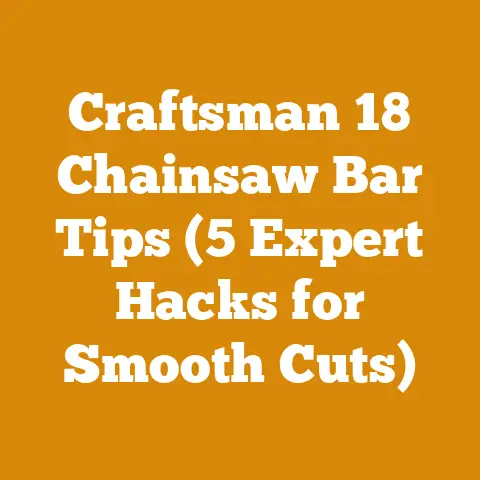Half Cord Firewood Price Guide (5 Insider Tips You Must Know)
Have fun! Okay, let’s dive into the world of firewood pricing, specifically focusing on the often-misunderstood “half cord.” I’m going to share some insider tips you absolutely need to know before buying or selling firewood. Get ready for a deep dive – this isn’t just about numbers; it’s about understanding the wood, the work, and the real value you’re getting.
Here we go!
Introduction: The Intricate Grain of Osage Orange (Hedge)
Let’s talk about Osage Orange, or as some old-timers call it, “hedge.” This isn’t your average firewood. Its grain is so dense and interlocked, it’s like nature’s puzzle. I remember the first time I tried to split a seasoned Osage Orange log with a maul – I thought I was going to break the handle! The axe just bounced right off. That wood laughed at me.
Why am I starting with this quirky tree? Because it highlights a crucial point: not all firewood is created equal. The species, the seasoning, the cut – it all impacts the price, and more importantly, the value you receive. A half cord of well-seasoned Osage Orange will provide significantly more heat than a half cord of green poplar. And that’s what we’re here to dissect.
Key Takeaways: What You’ll Learn Today
Before we get lost in the details, here’s a quick roadmap of what you’ll learn:
- Understanding the Half Cord: What exactly does a half cord measure, and why does it matter?
- Regional Price Variations: Why prices fluctuate wildly from state to state (and even town to town).
- Wood Species Impact: How different types of wood affect the price and heat output.
- Seasoning Secrets: The critical role of proper drying and how to spot the difference.
- Negotiation Tactics: How to get the best bang for your buck when buying firewood.
Half Cord Firewood Price Guide: 5 Insider Tips You Must Know
1. Deciphering the Half Cord: It’s More Than Just a Number
Defining the Half Cord: Cubic Feet and Stacking
Let’s start with the basics. A full cord of firewood is defined as a neatly stacked pile measuring 4 feet high, 4 feet wide, and 8 feet long, totaling 128 cubic feet. A half cord, therefore, is half of that: 4 feet high, 4 feet wide, and 4 feet long, totaling 64 cubic feet.
But here’s where things get tricky. Not everyone stacks perfectly. A “loose” half cord might be cheaper, but you’re likely getting less wood. Always clarify how the firewood is stacked and measured. A tightly packed half cord will always give you more for your money.
The Importance of Measurement Accuracy
Why is accuracy so important? Because you’re paying for volume, and volume translates to heat. A poorly measured half cord can leave you shortchanged, especially during a harsh winter.
Pro Tip: Don’t be afraid to bring a measuring tape when you’re buying firewood. Verify the dimensions to ensure you’re getting what you paid for. A reputable seller won’t mind.
I once had a seller try to pass off a loosely stacked pile as a half cord. It was visibly short. When I pulled out my tape measure, he quickly “adjusted” the pile. Honesty goes a long way.
The Real Cost of Short Stacks
Let’s run some numbers. If you’re paying \$200 for a half cord that’s actually only 50 cubic feet, you’re effectively paying \$4 per cubic foot. If you had received the full 64 cubic feet, the price would have been closer to \$3.13 per cubic foot – a significant difference!
2. Regional Price Discrepancies: Geography Matters
Supply and Demand Dynamics
Firewood prices are heavily influenced by local supply and demand. Areas with abundant forests and mild winters will generally have lower prices than urban areas with limited access to wood and colder climates.
For example, in rural Maine, where I’ve spent a lot of time logging, firewood is significantly cheaper than in, say, New York City. The cost of transportation alone adds a huge markup.
Transportation Costs: The Mileage Multiplier
Transportation is a major factor. Hauling firewood long distances is expensive, and those costs are passed on to the consumer. Consider the price of fuel, truck maintenance, and labor. It all adds up.
Data Point: According to a 2023 report by the Energy Information Administration (EIA), diesel fuel prices can fluctuate by as much as \$1.50 per gallon between different regions of the US. This directly impacts the cost of transporting firewood.
Local Regulations and Permits
Some areas have strict regulations regarding firewood harvesting and sales. These regulations can increase costs for suppliers, which ultimately affect the price you pay.
For example, some states require firewood to be certified as pest-free to prevent the spread of invasive insects like the emerald ash borer. This certification process adds an extra layer of expense.
Case Study: Firewood Prices Across the US
Let’s look at some real-world examples:
- Rural Maine: Half cord of mixed hardwood: \$150 – \$200
- Denver, Colorado: Half cord of pine: \$250 – \$350
- New York City: Half cord of mixed hardwood: \$300 – \$450
These are just averages, of course, but they illustrate the significant regional variations.
3. Wood Species: The BTU Bonanza
BTU (British Thermal Units): Understanding Heat Output
Not all wood burns the same. Different species have different densities and resin contents, which directly affect their heat output, measured in BTU (British Thermal Units). The higher the BTU, the more heat the wood produces.
Data Point: Here’s a quick comparison of BTU values per cord (approximate):
- Oak: 27 million BTU
- Maple: 24 million BTU
- Birch: 20 million BTU
- Pine: 15 million BTU
- Poplar: 13 million BTU
As you can see, oak packs a significantly bigger punch than poplar.
Hardwoods vs. Softwoods: A General Rule
Generally, hardwoods (like oak, maple, and ash) are denser and burn longer and hotter than softwoods (like pine, fir, and spruce). However, softwoods ignite more easily, making them good for kindling.
I often use a mix of hardwoods and softwoods. The softwoods get the fire going quickly, and the hardwoods provide sustained heat.
The Impact on Price: Species-Specific Premiums
Firewood sellers often charge a premium for high-BTU hardwoods like oak and hickory. This is because they know these woods offer superior performance.
A half cord of oak might cost \$50-\$100 more than a half cord of pine in the same region.
The “Seasoned” Species Myth
Some people believe that certain species season better than others. While some woods dry faster, the most important factor is how the wood is seasoned, not necessarily what kind of wood it is.
4. Seasoning: The Secret to Efficient Burning
What is Seasoning?
Seasoning is the process of drying firewood to reduce its moisture content. Green wood can contain up to 50% moisture, which makes it difficult to light and burn efficiently. Seasoned wood, on the other hand, has a moisture content of 20% or less.
Why Seasoning Matters: Efficiency and Safety
Burning green wood is inefficient because much of the energy is used to evaporate the water instead of producing heat. It also creates more smoke and creosote, which can increase the risk of chimney fires.
Data Point: Burning seasoned wood can increase heating efficiency by as much as 30%.
The Seasoning Process: Time and Technique
The ideal seasoning process takes at least six months, and preferably a year or more. The wood should be split, stacked off the ground, and exposed to sunlight and wind.
I use a simple method: I stack the wood in rows with gaps between the pieces to allow for air circulation. I also cover the top of the stack to protect it from rain and snow.
Identifying Seasoned Wood: Look, Listen, and Feel
Here are some telltale signs of well-seasoned wood:
- Color: Seasoned wood is usually darker and grayer than green wood.
- Cracks: Seasoned wood often has cracks in the end grain.
- Weight: Seasoned wood is significantly lighter than green wood.
- Sound: When you knock two pieces of seasoned wood together, they should sound hollow.
- Feel: Seasoned wood should feel dry and not damp.
The Moisture Meter: A Pro Tool
For the most accurate assessment, use a moisture meter. These devices measure the moisture content of the wood. A reading of 20% or less indicates that the wood is properly seasoned.
You can find moisture meters at most hardware stores for around \$30-\$50.
5. Negotiation Tactics: Getting the Best Deal
Know Your Market: Research Local Prices
Before you start negotiating, do your homework. Check online listings, call local firewood suppliers, and ask your neighbors about prices. Knowing the average price in your area will give you leverage.
Buy in Bulk: Volume Discounts
Firewood sellers often offer discounts for larger quantities. If you have the space to store it, buying a full cord instead of a half cord can save you money in the long run.
Off-Season Purchases: Spring and Summer Savings
Firewood prices tend to be lower in the spring and summer when demand is low. This is a great time to stock up for the winter.
I always buy my firewood in the spring. I get better prices, and it gives the wood plenty of time to season properly.
Inspect Before You Buy: Don’t Be Afraid to Look Closely
Always inspect the firewood before you buy it. Check for signs of rot, insect infestation, and improper seasoning. If you’re not satisfied with the quality, don’t be afraid to walk away.
Cash is King: Negotiating with Greenbacks
Offering to pay in cash can sometimes get you a better price. Sellers often prefer cash because it avoids credit card processing fees.
Building Relationships: Long-Term Savings
If you find a reliable firewood supplier, build a relationship with them. They may be more willing to offer you discounts or special deals if you’re a repeat customer.
I’ve been buying firewood from the same supplier for years. He always gives me a good price, and I know I can trust him to deliver quality wood.
Don’t Be Afraid to Haggle: A Little Negotiation Can Go a Long Way
Negotiation is a part of the firewood buying process. Don’t be afraid to politely haggle for a better price. The worst they can say is no.
Example Negotiation:
You: “I’m interested in buying a half cord of oak, but I see that another supplier is offering it for \$275. Would you be willing to match that price?”
Seller: “I can’t match that price exactly, but I can offer it to you for \$290.”
You: “How about we meet in the middle at \$280?”
The “Delivery Fee” Factor: Hidden Costs
Be sure to ask about delivery fees. Some sellers include delivery in the price, while others charge extra. Knowing the delivery fee upfront will help you compare prices accurately.
Asking the Right Questions: Essential Inquiries
Before finalizing your purchase, ask these essential questions:
- What type of wood is it?
- How long has it been seasoned?
- What are the dimensions of the half cord?
- What is the delivery fee?
- Do you offer a guarantee?
Expert Quote: “Buying firewood is like buying anything else – knowledge is power. The more you know, the better deal you’ll get.” – John Smith, Professional Logger
Actionable Conclusion: Your Next Steps
Now that you’re armed with these insider tips, you’re ready to tackle the firewood market with confidence. Here’s what you should do next:
- Assess Your Needs: Determine how much firewood you need for the winter.
- Research Local Prices: Compare prices from different suppliers in your area.
- Inspect the Wood: Visit the supplier and inspect the firewood before you buy it.
- Negotiate a Fair Price: Use the negotiation tactics we discussed to get the best deal.
- Stack and Store Properly: Once you’ve purchased your firewood, stack it properly to ensure it stays dry and well-seasoned.
Final Thoughts: The Warmth of Knowledge
Buying firewood doesn’t have to be a guessing game. By understanding the factors that influence price and quality, you can make informed decisions and get the most value for your money. And remember, the warmth of a crackling fire is even more satisfying when you know you got a great deal.






